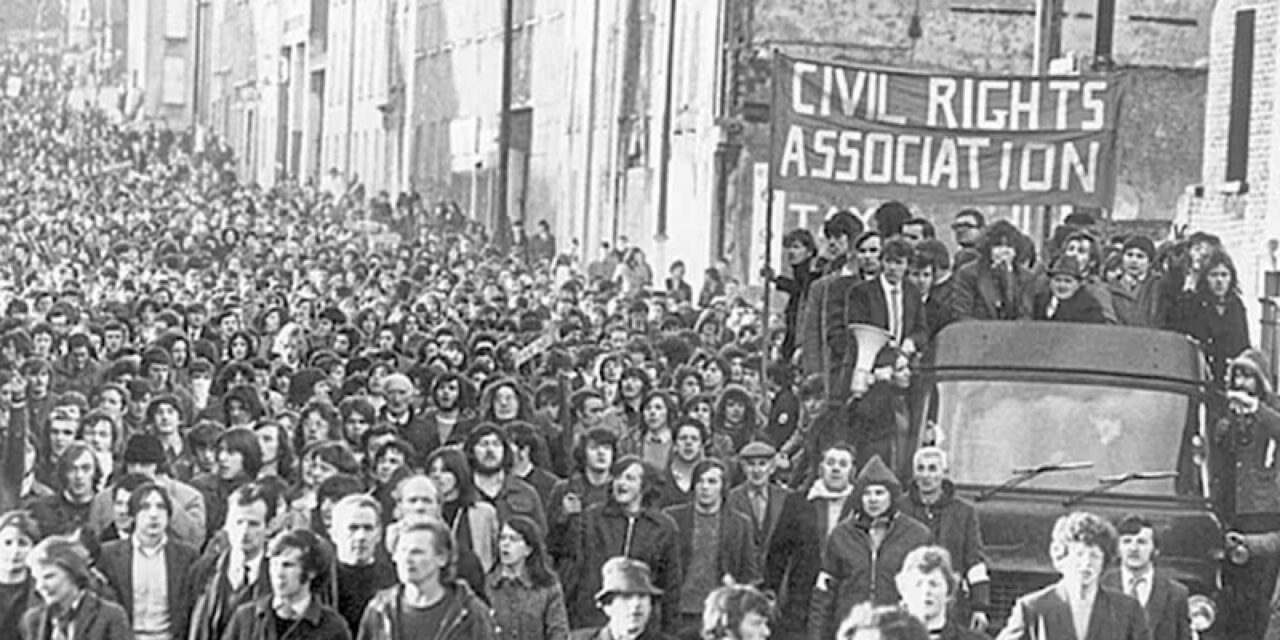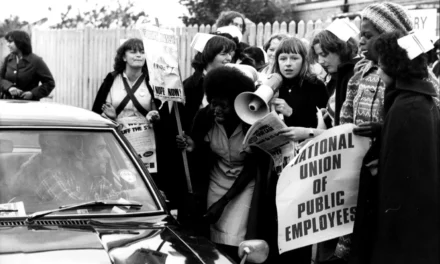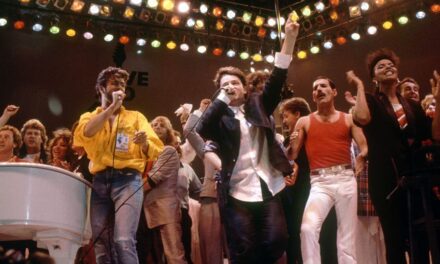1972 marked a complex transitional period for the United Kingdom. As the postwar consensus continued unraveling, Britain grappled with lingering social divides and economic uncertainty even amidst major cultural changes. The country’s future path remained unclear.
In music, glam rock groups like T.Rex, David Bowie, and Roxy Music achieved phenomenal success, their flamboyant styles and personas inspiring youth fashion. The Rolling Stones sold out their STP tour despite riotous crowds. Emerging talents Elton John and David Essex topped charts, signalling new directions in pop music. However, some feared glam rock’s escapist ethos distracted from challenging realities.
Entertainment also showed signs of transition. The Miss World pageant at London’s Royal Albert Hall was disrupted by feminist protesters throwing smoke bombs. Comedy entered new territory with provocative series like Monty Python’s Flying Circus and Till Death Us Do Part. Popular shows like Coronation Street now addressed weightier social issues. But traditional British reserve still pervaded mainstream programming.
Culturally, liberated sexual mores challenged old taboos, as reflected in racy films like Last Tango in Paris. Drug use also surged, concerning authorities but captivating youth. However, debates sharpened around racism, women’s rights, and Northern Ireland, with the Bloody Sunday tragedy galvanising Republic activists. Conflicts between traditional and progressive values created an unsettled mood.
Economically, 1972 brought currency upheaval when the Pound was floated against the dollar, beginning a new volatile era. Unemployment started creeping upward as outdated industries faltered, foreshadowing future reforms. Rampant inflation weakened living standards for many citizens. Nonetheless, hopes persisted for manufacturing’s revival.
The year also witnessed instability in politics. In March, the coal miners’ strike forced Prime Minister Heath to institute temporary 3-day work weeks to conserve electricity. The chaos highlighted fraying relations between government and unions. Later, the Sunningdale Agreement attempted resolving sectarian violence in Northern Ireland, though extremist resistance on both sides persisted.
Athletically, Britain had mixed fortunes. At the Summer Olympics, Mary Peters won gold in the women’s pentathlon, but boycotts and terrorism marred the Munich Games. In football, England failed to qualify for the Euro Championships, but cup victory brought relief to a recovering Manchester United after last year’s tragedy. New talents emerged like Nick Faldo revitalising British golf.
Overall, 1972 proved a complex year for the UK as old structures crumbled but the shape of the future remained hazy. Sectarian tensions, progressive new voices, economic uncertainty, and political instability left the nation suspended between eras. Yet creative new stirrings in music and culture offered hope. The path forward seemed both precarious and full of possibility.
In many ways, 1972 marked a microcosm of Britain’s awkward post-imperial adjustment and search for identity. The old establishment was fading, but no new order had yet solidified. As comforts of the 1960s eroded, the nation sailed into the unknown – sometimes excited, elsewhere anxious. But through it all, the changes brewing revealed a culture in energetic transition. Whatever lay ahead, the Britain of 1972 stood poised at a turning point as a new age struggled to be born.

Music
David Bowie Releases Ziggy Stardust
In 1972, the ever-evolving David Bowie unveiled his breakthrough album, “The Rise and Fall of Ziggy Stardust and the Spiders from Mars.” This seminal work pioneered the glam rock genre, with Bowie’s androgynous, otherworldly persona captivating audiences. The album’s blend of rock, pop, and avant-garde influences, coupled with its exploration of fame, identity, and societal norms, solidified Bowie’s status as a musical visionary.
Bowie’s creation of the Ziggy Stardust character marked a turning point in his career, as he fully embraced the concept of the rock star as a theatrical persona. The album’s narrative follows the rise and fall of Ziggy, an alien rockstar who arrives on Earth with a message of hope and salvation, only to be ultimately consumed by his own fame and excess.
Tracks like “Starman,” “Suffragette City,” and the title track became instant classics, showcasing Bowie’s unique vocal style, innovative songwriting, and ability to seamlessly blend genres. The album’s impact extended beyond the music itself, with Bowie’s flamboyant fashion choices and gender-bending performances challenging societal norms and inspiring generations of artists to push boundaries and explore new forms of self-expression.
“The Rise and Fall of Ziggy Stardust and the Spiders from Mars” not only cemented Bowie’s place as a musical icon but also encapsulated the spirit of the early 1970s, a time of cultural upheaval, artistic experimentation, and the blurring of lines between music, fashion, and performance art. The album’s enduring legacy is a testament to Bowie’s unparalleled creativity and his ability to capture the zeitgeist of an era.
The Rolling Stones Hit No.1 with “Angie”
The Rolling Stones, one of Britain’s most enduring rock bands, topped charts on both sides of the Atlantic with the emotive ballad “Angie” from their album “Goats Head Soup.” Released in August 1973, “Angie” marked a departure from the Stones’ signature hard-driving rock sound, showcasing a softer, more introspective side of the band.
The song’s tender melody and Mick Jagger’s heartfelt vocals struck a chord with listeners, as he sang of the pain and heartbreak of a failing relationship. The lyrics, penned by Jagger and Keith Richards, were inspired by a variety of sources, including Richards’ newborn daughter Angela and Jagger’s tumultuous relationship with his then-wife Bianca.
“Angie” became the Stones’ seventh #1 hit in the United States and spent two weeks atop the UK Singles Chart, cementing its status as one of the band’s most successful and beloved tracks. The song’s popularity also helped propel “Goats Head Soup” to the top of the charts, marking the Stones’ 11th studio album and further solidifying their status as rock royalty.
The success of “Angie” demonstrated the Rolling Stones’ versatility and ability to adapt to changing musical trends while still maintaining their distinctive sound and style. The song’s enduring appeal has made it a staple of the band’s live performances and a favourite among fans, serving as a testament to the Stones’ ability to craft timeless, emotionally resonant music that transcends generations.

Don McLean’s “American Pie” Tops Charts
American singer-songwriter Don McLean’s metaphorical folk-rock epic “American Pie” reached #2 in the UK for a month in 1972. The song’s cryptic lyrics, alluding to the loss of innocence in American culture and the music industry, intrigued listeners and sparked countless interpretations.
Released in late 1971, “American Pie” quickly became a cultural phenomenon, with its enigmatic references to iconic figures like Bob Dylan, The Beatles, and Buddy Holly, whose tragic death in a 1959 plane crash was famously described as “the day the music died.” McLean’s poetic and nostalgic storytelling struck a chord with audiences on both sides of the Atlantic, as he wove together a tapestry of American history, culture, and music.
At over eight minutes long, “American Pie” defied conventional radio formats, yet its captivating narrative and memorable chorus kept listeners engaged throughout. The song’s success in the UK highlighted the enduring appeal of well-crafted, thought-provoking music that transcends national boundaries.
McLean’s masterpiece has since been covered by numerous artists, featured in films and television shows, and has become an integral part of the American songbook. Its lasting impact on popular culture is a testament to the power of music to capture the spirit of an era and to provide a shared experience that unites listeners across generations.
The success of “American Pie” in the UK also underscored the enduring transatlantic exchange of musical ideas and influences, as British audiences embraced this quintessentially American song and made it their own. The song’s popularity in 1972 served as a reminder that, despite the social and political turbulence of the time, music remained a powerful force for connection, reflection, and cultural commentary.
Entertainment
I Claudius Production Begins
In 1972, the BBC commenced filming the acclaimed historical drama series “I, Claudius,” starring Derek Jacobi as the Roman emperor Claudius. Based on Robert Graves’ novels, the series chronicled the tumultuous lives and reigns of the early Roman emperors.
The production of “I, Claudius” was a significant undertaking for the BBC, as the series aimed to bring the intricate world of ancient Rome to life on the small screen. With a stellar cast that included Siân Phillips as Livia, Brian Blessed as Augustus, and John Hurt as Caligula, the series boasted an impressive array of British acting talent.
The series’ success hinged on its ability to balance historical accuracy with compelling drama, and in this regard, “I, Claudius” excelled. The show’s writers, Jack Pulman and Robert Graves, meticulously adapted Graves’ novels, crafting a complex narrative that explored the machinations, intrigues, and personal lives of the Roman elite.
Derek Jacobi’s portrayal of Claudius, a role that would define his career, was a particular standout. His nuanced performance captured the emperor’s physical disabilities, keen intellect, and the challenges he faced in navigating the treacherous world of Roman politics.
The series’ attention to historical detail was evident in its lavish sets and costumes, which transported viewers to the opulent palaces and bustling streets of ancient Rome. The show’s commitment to authenticity extended to its use of Latin phrases and its depiction of Roman customs and traditions.
When “I, Claudius” premiered in 1976, it was met with critical acclaim and quickly gained a devoted following. The series set a new standard for historical dramas on British television, paving the way for future productions like “Rome” and “The Tudors.”
Today, “I, Claudius” is regarded as a landmark in British television history, a testament to the BBC’s commitment to producing high-quality, thought-provoking dramas that engage and educate audiences. The series’ enduring legacy is a reminder of the power of storytelling to bring history to life and to shed light on the timeless themes of power, ambition, and the human condition.

The Canterbury Tales Premieres
Italian filmmaker Pier Paolo Pasolini’s provocative film “The Canterbury Tales” premiered in 1972, loosely adapted from Geoffrey Chaucer’s 14th-century story collection. Pasolini’s interpretation of the classic tales was marked by its frank depiction of sexuality and its critique of religious hypocrisy.
Pasolini, known for his controversial and politically charged works, sought to update Chaucer’s stories for a modern audience, infusing them with his own unique blend of social commentary and artistic vision. The film’s episodic structure mirrored that of the original tales, with each segment focusing on a different character and their moral and sexual transgressions.
The film’s explicit content, which included nudity and sexual situations, pushed the boundaries of what was considered acceptable in mainstream cinema at the time. Pasolini’s unflinching portrayal of the characters’ desires and vices was intended to challenge viewers’ preconceptions and to expose the hypocrisies of society, particularly those of the religious establishment.
The film’s release sparked controversy and censorship debates, reflecting the changing social mores of the time. Some critics praised Pasolini’s daring vision and his willingness to tackle taboo subjects, while others denounced the film as obscene and blasphemous.
Despite the mixed reception, “The Canterbury Tales” showcased Pasolini’s distinctive style and his ability to adapt classic literature for the screen. The film’s bold visual aesthetic, which combined elements of medieval art with modern cinematic techniques, created a unique and striking viewing experience.
Pasolini’s “The Canterbury Tales” remains a significant work in the history of Italian cinema, a testament to the director’s uncompromising artistic vision and his commitment to challenging societal norms. The film’s premiere in 1972 marked a watershed moment in the ongoing debate over artistic freedom and censorship, and its legacy continues to inspire filmmakers and scholars alike.
Culture
British European Airways Plane Hijacked
In 1972, a British European Airways plane en route from London to Brussels was hijacked by Palestinian terrorists. The incident, which took place against the backdrop of heightened tensions in the Middle East, shocked the nation and highlighted the growing threat of international terrorism.
On the evening of February 2, 1972, flight BE612, a Vickers Vanguard turboprop aircraft, took off from London’s Heathrow Airport with 61 passengers and crew onboard. Shortly after reaching cruising altitude, two men armed with guns and hand grenades took control of the plane, demanding that the pilot divert to Beirut, Lebanon.
The hijackers, later identified as members of the Palestinian terrorist organisation Black September, sought to use the hijacking as a means to secure the release of Palestinian prisoners held in Israeli jails and to draw international attention to their cause.
Upon landing in Beirut, the hijackers released the majority of the passengers, keeping a small group of hostages onboard as they negotiated with authorities. The tense standoff lasted for several days, as British and Lebanese officials worked to secure the safe release of the remaining hostages.
The incident ended with the release of the passengers and crew, but not before the hijackers had destroyed the aircraft on the tarmac. The hijacking of BE612 was a stark reminder of the growing threat of international terrorism and the vulnerability of air travel in an increasingly interconnected world.
The event also brought the complex geopolitical issues of the Middle East closer to home for many Britons, as the conflict between Israel and Palestine spilled over into the realm of international travel and diplomacy. The hijacking sparked a renewed focus on aviation security and the need for enhanced measures to protect passengers and crew from the threat of terrorism.
In the wake of the incident, the British government and the international community grappled with the challenge of balancing the need for security with the desire to maintain the freedom and convenience of air travel. The hijacking of BE612 served as a sobering reminder of the risks and uncertainties of the modern world and the ongoing struggle to find peaceful solutions to long-standing conflicts.

Notting Hill Carnival Expanded
Europe’s biggest street carnival was held in Notting Hill, London, in 1972, celebrating Caribbean culture and diversity. The carnival’s origins can be traced back to the late 1950s, when the West Indian community in London organised a festival to promote cultural unity and combat racial tensions.
In the years following World War II, many immigrants from the Caribbean settled in the Notting Hill area, seeking employment and a better life in the UK. However, they often faced discrimination, prejudice, and even violence from some segments of the local population.
In response to these challenges, community leaders like Claudia Jones, a Trinidadian activist and journalist, sought to create a event that would bring the Caribbean community together and showcase their rich cultural heritage to the wider British public.
The first Notting Hill Carnival, held in 1966, was a small-scale event featuring steel bands, costumed dancers, and Caribbean food stalls. Over the next few years, the carnival grew in size and scope, attracting more participants and spectators from across London and beyond.
By 1972, the event had grown into a full-fledged carnival, featuring vibrant costumes, Caribbean music, and delicious food. The streets of Notting Hill came alive with the sights, sounds, and smells of the Caribbean, as thousands of revellers danced to the rhythms of soca, calypso, and reggae.
The Notting Hill Carnival quickly became a beloved annual tradition, showcasing the richness of Caribbean culture and fostering a sense of community and inclusivity in the heart of London. The carnival also served as a powerful symbol of the city’s growing diversity and the important contributions of its immigrant communities.
Over the years, the Notting Hill Carnival has faced challenges, including occasional outbreaks of violence and tensions with the police. However, the carnival’s organisers and supporters have worked tirelessly to ensure that the event remains a safe and welcoming space for all, promoting unity, understanding, and celebration of diversity.
Today, the Notting Hill Carnival is the largest street festival in Europe, attracting over a million visitors each year. It stands as a testament to the resilience and creativity of London’s Caribbean community and a powerful reminder of the importance of embracing and celebrating the diversity that enriches our societies.

Silent Comedy Star Max Linder Dies
In 1972, the world of comedy mourned the loss of Max Linder, a revered French silent film comedian who passed away in Paris. Linder, often considered a pioneer of film comedy and a major influence on Charlie Chaplin, had a career that spanned from the early 1900s to the 1920s.
Born Gabriel-Maximilien Leuvielle in 1883, Linder began his entertainment career as a stage actor and comedian in the Parisian music halls. In 1905, he made his first appearance on film and quickly became one of the most popular and influential comedic actors of the silent era.
Linder’s on-screen persona, “Max,” was a dapper, well-dressed man with a silk hat and a cane, often finding himself in comical situations due to his own misadventures or social faux pas. His innovative use of physical comedy, clever gags, and charming on-screen presence made him a global star during the early 20th century.
Linder’s films, such as “Max Speaks English” (1914), “Max and the Jealous Husband” (1914), and “Seven Years Bad Luck” (1921), showcased his talent for crafting memorable, hilarious scenes and his ability to connect with audiences through his expressive performances.
In addition to his acting career, Linder was also a pioneering filmmaker, directing and producing many of his own films. He played a significant role in shaping the development of film comedy, experimenting with techniques like close-ups, tracking shots, and editing to create more dynamic and engaging comedic sequences.
Linder’s influence on the world of comedy cannot be overstated, with many of the most iconic comedians of the 20th century, including Charlie Chaplin, Buster Keaton, and Harold Lloyd, citing him as a major inspiration for their own work. Chaplin, in particular, acknowledged Linder’s influence, once stating, “Max was the professor. I was the student.”
Despite his success and popularity, Linder’s personal life was marked by tragedy and struggle. He suffered from severe depression and health issues, which were exacerbated by injuries sustained during World War I and the changing tastes of audiences in the 1920s.
Linder’s untimely death in 1972 at the age of 89 was a loss felt deeply by the international film community. His contributions to the art of comedy were recognised and celebrated by the industry, with tributes and retrospectives held in his honour.
Today, Max Linder’s legacy continues to inspire and influence new generations of comedians and filmmakers. His innovative techniques, timeless humour, and enduring on-screen presence serve as a reminder of the power of laughter and the importance of the early pioneers who helped shape the medium of film.
As the world of comedy continues to evolve and change, the impact of Max Linder’s work remains a testament to the enduring appeal of well-crafted, innovative comedy that transcends language and culture. His contributions to the art form will forever be remembered and celebrated as an integral part of the history of film and entertainment.
Politics
UK Signs Treaty Joining European Community
In 1972, after years of debate and negotiation, the United Kingdom signed a treaty to join the European Economic Community (EEC), the precursor to the European Union. The decision, made under the leadership of Prime Minister Edward Heath, marked a significant shift in British foreign policy and economic strategy.
The UK’s relationship with the EEC had been a topic of discussion since the community’s formation in 1957. Initially, the UK had been skeptical of the EEC, preferring to maintain its close ties with the Commonwealth and its role as a global power. However, as the economic benefits of membership became more apparent, the UK’s stance began to change.
Supporters of joining the EEC argued that membership would provide access to a larger market, boost economic growth, and enhance the UK’s global influence. They believed that being part of a strong, united European community would help the UK navigate the challenges of the Cold War era and maintain its position on the world stage.
However, the decision to join the EEC also faced significant opposition from those concerned about the loss of national sovereignty and the potential impact on British industries. Some worried that membership would lead to increased competition from European firms and that the UK would be forced to adopt policies and regulations that were not in its best interests.
Despite these concerns, Prime Minister Heath and his government pushed forward with the negotiations, ultimately securing terms that they believed would protect British interests while allowing the country to reap the benefits of membership.
The signing of the treaty in 1972 marked a historic moment for the UK and Europe as a whole. It set the stage for a new era of cooperation and integration between the UK and its European neighbours, laying the foundation for the creation of the European Union.
However, the UK’s relationship with Europe would remain a complex and often contentious issue in the decades that followed. The debate over the balance between national sovereignty and European integration would continue to shape British politics, ultimately leading to the UK’s decision to leave the European Union in 2016.
Despite the challenges and uncertainties that lay ahead, the signing of the treaty in 1972 remains a pivotal moment in British and European history, one that has had a profound impact on the economic, political, and social landscape of the continent.

Bloody Sunday Occurs in Northern Ireland
On January 30, 1972, a tragic event known as “Bloody Sunday” occurred in Derry, Northern Ireland, marking a turning point in the conflict known as “The Troubles.” The incident unfolded during a civil rights protest against the internment without trial of suspected Irish Republican Army (IRA) members.
The march, organised by the Northern Ireland Civil Rights Association, began peacefully, with thousands of protesters taking to the streets to demand an end to discriminatory practices against the Catholic minority in Northern Ireland. However, as the march approached the Bogside area of Derry, it was met by British soldiers who had been deployed to maintain order.
What happened next remains a matter of intense controversy and debate. As the soldiers and protesters faced off, violence erupted, and the soldiers opened fire on the crowd. In the chaos that ensued, 13 unarmed protesters were killed, and another 15 were wounded. One of the wounded would later die from his injuries, bringing the total death toll to 14.
The events of Bloody Sunday sent shockwaves throughout Northern Ireland and the United Kingdom. The Catholic community was outraged by what they saw as an unprovoked attack on peaceful protesters, while the British government and military maintained that the soldiers had been responding to a threat.
In the immediate aftermath of the shooting, the British government launched an inquiry, known as the Widgery Tribunal, to investigate the events of Bloody Sunday. However, the tribunal’s findings, which largely exonerated the soldiers and blamed the protesters for the violence, were widely criticised as a whitewash.
For many in the Catholic community, Bloody Sunday was a stark reminder of the systemic discrimination and oppression they faced under British rule. The incident fuelled support for the IRA and other republican groups, who saw armed struggle as the only means of achieving their goal of a united Ireland.
In the years that followed, the events of Bloody Sunday continued to cast a long shadow over Northern Ireland. It wasn’t until 1998, with the signing of the Good Friday Agreement, that a fragile peace was achieved and the process of reconciliation began.
In 2010, a second inquiry, known as the Saville Inquiry, was published, overturning the findings of the Widgery Tribunal and concluding that the soldiers had fired on the protesters without justification. The report led to an official apology from British Prime Minister David Cameron, who described the events of Bloody Sunday as “unjustified and unjustifiable.”
Today, Bloody Sunday remains a deeply painful and controversial chapter in the history of Northern Ireland and the United Kingdom. It serves as a reminder of the tragic human cost of conflict and the importance of building a just and peaceful society for all.

Coal Miners Go On Strike
In 1972, coal miners across Britain commenced a major strike action over pay disputes. The strike, which lasted for several weeks, had far-reaching consequences for the nation’s energy supply and economy.
At the time, coal was the primary source of energy for the UK, with coal-fired power stations generating the majority of the country’s electricity. The coal industry was also a major employer, with thousands of miners working in pits across the country.
The strike began in January 1972, when the National Union of Mineworkers (NUM) rejected an offer from the National Coal Board (NCB) for a pay increase that the union deemed insufficient. The NUM demanded a substantial wage increase and improved working conditions for its members.
As the strike progressed, the effects on the nation’s energy supply became increasingly apparent. With coal production halted, many power stations were forced to reduce their output or shut down entirely, leading to widespread power cuts and blackouts.
The strike also had a significant impact on other industries, as factories and businesses that relied on coal-powered electricity were forced to reduce their operations or close altogether. The economic disruption caused by the strike led to concerns about the long-term competitiveness of British industry.
The government, led by Prime Minister Edward Heath, initially took a hard line against the strikers, declaring a state of emergency and implementing measures to conserve electricity. However, as the strike dragged on and public support for the miners grew, the government was forced to negotiate.
In February 1972, after weeks of intense talks, the NUM and NCB reached an agreement that granted the miners a substantial pay increase and improved working conditions. The strike was called off, and the miners returned to work.
The coal miners’ strike of 1972 was a pivotal moment in British labor history, demonstrating the power of organised labor and the importance of collective bargaining. It also highlighted the challenges facing the country’s traditional industries in an increasingly globalised economy.
In the years that followed, the British coal industry would continue to face significant challenges, including competition from imported coal and the rise of alternative energy sources. The closure of many coal pits in the 1980s and 1990s would have a devastating impact on mining communities across the country.
Today, the coal miners’ strike of 1972 is remembered as a defining moment in British history, one that highlighted the complex social and economic challenges facing the nation in the post-war era. It serves as a reminder of the importance of fair wages, safe working conditions, and the power of collective action in the face of adversity.

Sports
Great Britain Win 18 Olympic Medals
At the 1972 Munich Olympics, Team GB delivered a strong performance, winning a total of 18 medals, including 5 golds. This was their best tally in decades, marking a resurgence in British Olympic success.
The gold medals came from a diverse range of sports, showcasing the depth and breadth of British athletic talent. In cycling, the men’s team pursuit squad of Ian Hallam, Ron Keeble, Michael Bennett, and William Moore took gold, setting a new world record in the process.
In swimming, David Wilkie won gold in the men’s 200-meter breaststroke, becoming the first British swimmer to win an Olympic title since 1960. Wilkie’s victory was all the more impressive given that he had suffered a broken collarbone just months before the Games.
In sailing, Rodney Pattisson and Christopher Davies won gold in the Flying Dutchman class, while David Hunt and Stewart Morris took gold in the Tempest class. These victories continued Britain’s strong tradition in Olympic sailing.
Perhaps the most memorable gold medal for Team GB in Munich came in athletics, where Mary Peters won the women’s pentathlon. Peters’ victory was a remarkable achievement, as she had been competing in international athletics for over a decade and had finished fourth in the pentathlon at the previous Olympics in Mexico City.
Peters’ gold medal was the culmination of years of hard work and dedication, and her success helped to inspire a new generation of British athletes. Her achievement was all the more poignant given the tragic events that unfolded at the Munich Olympics, with the terrorist attack on the Israeli team quarters casting a shadow over the Games.
In addition to the gold medals, Team GB also won one silver and two bronze medals in Munich. The silver came in the men’s cox-less pairs rowing event, while the bronzes were won in cycling and sailing.
The success of Team GB at the Munich Olympics was a cause for celebration and national pride, coming at a time when the country was facing significant challenges at home and abroad. The athletes’ achievements helped to unite the nation and provided a much-needed boost to morale.
The Munich Olympics also marked a turning point for British Olympic sport, as the government began to invest more heavily in athlete development and support. This investment would pay off in the decades that followed, with British athletes achieving ever-greater success on the international stage.
Today, the achievements of Team GB at the 1972 Munich Olympics are remembered as a high point in British Olympic history, a moment when the nation’s athletes proved that they could compete with the best in the world and emerge victorious.
The year 1972 proved a momentous one for the United Kingdom, marked by both steps forward and turbulent growing pains as the nation navigated a complex landscape of social, economic, and political challenges. As Britain sought to redefine its role in the modern world, the events of 1972 highlighted the difficulties of reconciling tradition and progress.
A major milestone came with the UK’s accession to the European Economic Community in January, pointing toward greater integration with Europe. However, the year also saw major disruptions like the coal miners’ strike, reflecting ongoing domestic labor struggles. Further strikes by rail workers and others revealed fraying social contracts, even amidst progress on issues like equal pay.
Culturally, 1972 saw youth embrace glam rock’s flamboyant sound and aesthetic as a form of escapism from grim realities. Creators like David Bowie became icons of self-reinvention and sexual liberation. However, some feared glam rock distracted from the UK’s problems. Film and TV also grew more permissive with provocative content, though establishment sensibilities still dominated mainstream programming.
Women’s rights surged forward with the passage of the Equal Pay Act, but the Miss World contest erupted in feminist protest at the Royal Albert Hall, signaling society’s lingering chauvinism. In Northern Ireland, Bloody Sunday became a tragic flashpoint escalating sectarian violence, despite attempted reconciliation through the Sunningdale Agreement.
Economically, floating the pound ushered in an unstable new currency era reflecting Britain’s uncertain position. Joblessness grew as old industries declined, foreshadowing the need for difficult reforms. Rampant inflation also eroded living standards, adding to a mood of frustration and malaise.
In politics, the Heath government struggled to balance ideologically opposing factions, from trade unions to Northern Irish extremists. Global events like the Munich Olympics massacre and hijacking of a British airliner heightened a mood of instability and threat. Yet the UK’s first disabled MP, Henry Faulds, also marked progress.
Overall, 1972 saw Britain torn between old and new identities, struggling to overcome past divisions while unsure of its future. But the year’s defining events also reflected a society in energetic transition. The path forward promised to be difficult, yet carried glimmers of hope that the nation might emerge renewed.















